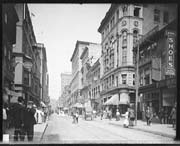|
|
|
A BRIEF HISTORY OF PROVIDENCE When Roger Williams and his followers first settled the Providence area in the 1630s, their economy was entirely based on farming, but by the eve of the American Revolution, the town had a busy maritime trade and a mix of merchants and industries supporting the port. During this era, Providence had become an important player in the Triangle Trade: an economy built on trade in slaves, sugar products, and rum. Providence distilleries turned West Indies sugar and molasses into rum, which was traded for slaves, who worked the West Indies sugar plantations and were imported into the Colonies. It was an ugly business, but it brought great wealth to the New England merchants, industrialists, and sea captains who engaged in the Triangle. When England passed the Sugar Act of 1764 to levy an import tax on sugar products, Providence residents felt their livelihood threatened and, consequently, were among the first Colonists to agitate against British rule. The city played an important role in the American Revolution, providing leadership and fighting strength, quartering troops, and supplying goods to war-starved residents by circumventing the blockade of Newport.
The railroad came to Providence in 1835, from Boston to the north, and this gave the city an additional boost. In a short time, it would be considered a regional hub because of its great transportation network of railroads, canals, turnpikes, and port. Factories continued to spring up and grow as a result. There was plenty of work for skilled and unskilled labor, which attracted foreign immigrants. The Irish were the first to come, adding a layer of ethnic unrest within predominantly white Anglo-Saxon Protestant Providence. Political struggles arose over the right to vote. Blacks had already been disenfranchised and the new white working class was soon unhappy over state law that only allowed property holders to vote. In the 1830s the Providence Workingmen’s Association began calling for voting reform. By 1843, a new state constitution satisfied the native but not the naturalized citizen: naturalized citizens could vote only if they owned property; whereas native citizens, if landless, could perform a day’s militia service or pay a registry tax to satisfy their voting requirement. Due to a shrewd political alliance during the constitutional debates, blacks re-gained the vote with the new constitution. (Until the Civil Rights movement of the 1960s, African American citizens of Rhode Island were discouraged from voting in a number of subtle and not-so-subtle ways, but they never again relinquished the franchise.)
^back to
top
|
|
The
STORIES |
|
|
|
|

